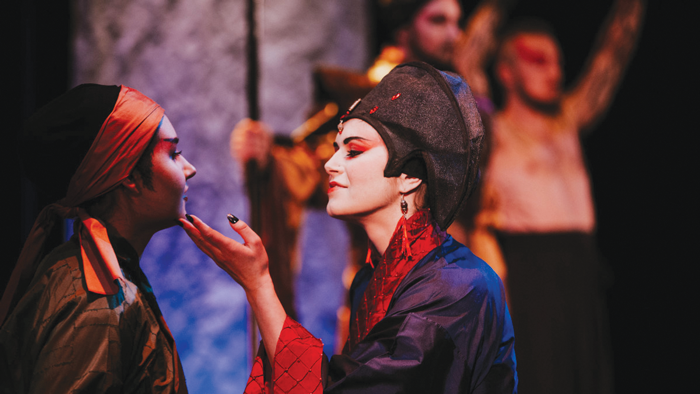From the cultural stereotypes in Madame Butterfly to the racism in Otello, the intersection of race and culture with opera has a dark and problematic history. Given this legacy, the East Asian setting and the specific Chinese cultural influences of Opera McGill’s production of Alcina is confusing, especially given the European libretto.
The production of Alcina, was, without a doubt, impressive and meticulous. The vocalists were mesmerizing, the orchestra colourful, and the dedication and preparation were evident throughout. The director, professor Patrick Hensen, reflected that Alcina is a lengthy and demanding opera.
“The difficulties are the length of these Handel operas—for both the students and today’s modern audience, and the vocal demands of a few roles.” The difficulties were evidently overcome in this seamless and engaging performance. The design elements of production, however, are where the East Asian influences are clear.
Hensen’s unusual setting of the opera was inspired by the Italian poem, “Orlando Furioso” by Ariosto, which inspired a 16th century Opera by Brochi, which later influenced Handel’s Alcina.
“In the Ariosto, there is a subplot concerning the saracen Ruggiero and his Christian girlfriend Bradamante. He is flown away by Hippogriff to Alcina’s island “east of India” where he’s enchanted by the sorceress Alcina,” Hensen explained. It was this location that provided the inspiration for the setting.
“So, it is from within this context that Vincent [Lefèvre, the set designer] and I sought to find a contextual setting in which to both experiment with marrying the flow and movement of Tai Chi with Handel’s music, as well as find what “east of India” might mean,” Hensen elaborated.
Many visual aspects of the production were influenced by Chinese culture. The set included a large Chinese coin representing a compass, designed by a professional Chinese acupuncturist, as well as sky lanterns in the shapes of planets and stars. The cast performed in traditional Chinese dress and makeup, and props, such as swords and parasols. The movement in the Opera was inspired by Tai Chi, and the cast trained in the ancient art for the production. Quick and short stepped motions by female characters, especially Alcina, appeared to evoke the ancient tradition of foot binding.
The setting and art direction of the production, however, has been the subject of controversy. Many students, including some involved in the production, feel uncomfortable about the risk of perpetuating orientalism in art—where depictions of Asia are stereotyped in a way that risk fetishizing a particular culture. When asked about the issue of cultural appropriation surrounding the opera, Hensen acknowledges that appropriation is an issue, but explains that he does not see it as relevant to the production. He sees the spread of culture as a vital component of opera.
“All opera, like all art, lives through a series of cultural exchanges that produce new art,” Hensen said. “For instance, Opera McGill’s production here in Montreal in 2016 is a remount of the original production in 2007 by a German composer’s Italian opera written for a 1735 English audience at Covent Garden that was based on a 16th century epic poem by the Italian Ariosto. This is just one example of how cultural exchange over centuries helped to create just one opera performance here at McGill, and how complicated art is when looking at source material and/or influences.”
In the specific context of Alcina, Hensen views the production as an amalgamation of several cultural influences.
“If we look right at these sources, Alcina’s characters are not Chinese, they are—if I was pressed to describe—a combination of backgrounds,” Hensen said. “Saracen [Ruggiero], Christian Europeans [Bradamante, Oberto], Sorceresses who live on a magical and mystical island somewhere east of India [Alcina and her sister Morgana], a wizard probably from Libya [Melisso], and Alcina’s general Oronte [probably a hired mercenary].”
Rebecca Jacobson, a violinist in the orchestra of Alcina, has opposing views on the setting of the opera.
“I guess I’m just trying to understand why,” she explains. “Handel did not write the opera for that setting, and there are so many other options for the production, and people were upset, so I just don’t understand.”
Jacobson also describes issues of difficult relationships within the cast and production members.
“There’s a difficult power dynamic, and it’s hard to explain. But no one wants to risk going to someone in authority. There’s really no way to talk about it,” Jacobson said.
When asked about resisting the opera’s artistic liberties, Jacobson emphasizes the integrity of the music.
“Many of my friends who weren’t involved in the production asked me why I wasn’t protesting,” Jacobson said. “But there are so many artists, especially the singers, who have been rehearsing for months, that it wasn’t fair to let the music suffer. They deserve for their music to be recognized.”
Regardless of the questionable setting, Jacobson is correct: The success of the music in Alcina was readily apparent. Race and culture in the production, however, was presented in an ethically dubious way, surrounded by conflicting discourses.









I can’t believe this is the pathetic level of discourse on university campuses these days. People are obsessed with having the right attitude and are incapable of transcending their juvenile and incoherent social/political agenda in order to appreciate an attempt to perform and interpret one of the greatest masterpieces we have, let alone talk about the deep human universals the opera deals with. The bigotry and ignorance is portrayed from the first paragraph.